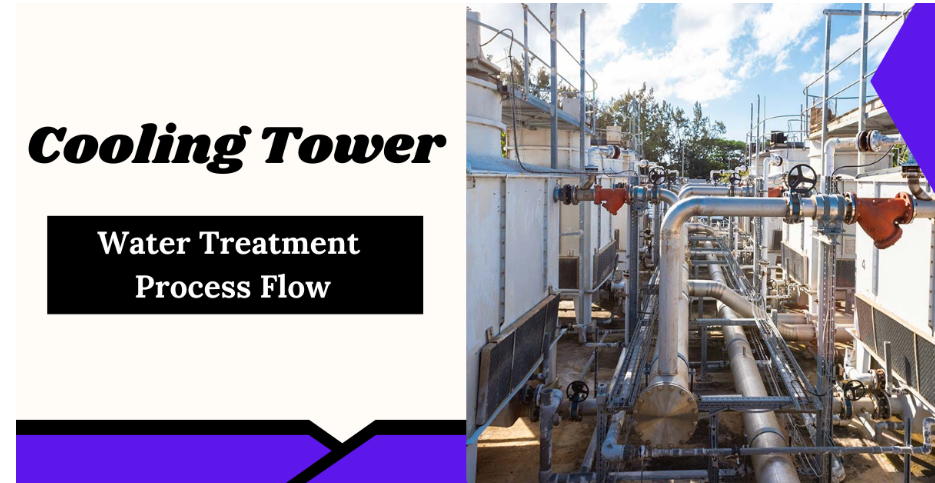Cooling towers are a critical component of industrial and HVAC systems. They help remove excess heat from processes, keeping systems running efficiently and preventing equipment from overheating. However, keeping these systems in top shape involves more than just routine inspections; proper cooling tower maintenance and water treatment are essential for efficiency, safety, and longevity.
If you’re managing a facility with cooling towers, you’ve likely heard about water treatment. But why is it so crucial? And what steps go into an effective treatment plan? This guide explores everything from the basics of cooling tower water treatment to advanced and cost effective solutions, giving you the knowledge to maintain your system efficiently.
Importance of Cooling Tower Water Treatment
Why is water treatment for cooling towers so important? Without it, systems can experience devastating issues such as scale buildup, corrosion, and harmful microbiological growth. These problems can lead to reduced efficiency, equipment failures, and costly repairs. Here’s how proper maintenance can make a world of difference:
- Prevents Scale Deposits: Buildup of calcium, silica, and other minerals leads to heat transfer inefficiencies.
- Reduces Corrosion: Chemical imbalances cause metal degradation, impacting the longevity of your equipment.
- Minimizes Microbial Risks: Unchecked microbial growth, including harmful bacteria like Legionella, can pose health risks and clog systems.
Treating city water as a source of makeup water is crucial to prevent issues like scaling and corrosion, as its quality can vary and may require specific treatment methods.
Effective water treatment can save you money by reducing maintenance and operating costs, improving heat transfer, cutting energy expenses, and minimizing water waste. Plus, it’s vital for complying with health and environmental standards.
Cooling Tower Water Treatment Process Flow

An effective water treatment system is a well-orchestrated process that ensures proper water quality and protects the overall system. Cooling tower blowdown is crucial in maintaining water quality by removing dissolved solids and debris. Here’s an overview of the typical process flow:
1. Makeup Water Intake
The process begins with makeup water intake, where raw water is drawn from a source such as a river, lake, or municipal supply. Surface water, which can originate from rivers or lakes, is also a common source of makeup water. This step includes removing large debris like leaves, twigs, or other particles using strainers and coarse filters.
Proper filtration at this stage ensures that large contaminants do not enter the system, protecting downstream equipment from damage and reducing fouling. Treating surface water to remove contaminants is crucial to maintain the quality of the makeup water before it enters the cooling system.
2. Pretreatment
Pretreatment is essential for reducing impurities such as hardness, silica, and other dissolved solids that can cause scaling and fouling. Techniques like reverse osmosis (RO), ultrafiltration, or water softening are commonly employed. RO systems remove up to 99% of contaminants, while water softeners target calcium and magnesium ions. Additionally, ion exchange resins are used in pretreatment to remove dissolved ions, protecting downstream equipment from fouling. Pretreatment ensures that the water quality meets the requirements for efficient system operation, extending the lifespan of equipment.
3. Chemical Addition
This step involves the precise introduction of chemicals to the water to address specific operational needs. Proper chemical dosing is critical to ensure the system operates efficiently, reduces maintenance needs, and minimizes the risk of equipment failure. Treatment chemicals are essential in preventing scale, corrosion, and microbial growth, ensuring compliance with industry standards.
Chemicals used:
- Scale inhibitors (e.g., polyphosphates, phosphonates): Prevent mineral deposits.
- Corrosion inhibitors (e.g., sodium molybdate, zinc orthophosphate): Protect metal surfaces.
- Biocides (e.g., chlorine, isothiazolinones): Control microbial growth.
- pH stabilizers (e.g., sodium carbonate, sodium hydroxide): Maintain water chemistry.
4. Circulation
Treated water is continuously circulated throughout the system to maintain thermal and operational balance. This ensures uniform water quality across all components and prevents localized issues like hotspots, scaling, or corrosion. Maintaining water quality in the recirculating water is crucial to prevent issues like scaling and corrosion. Effective circulation also enhances the system’s energy efficiency by optimizing heat transfer.
5. Side-Stream Polishing
Side-stream filtration or polishing is a key step to remove suspended solids, organic matter, and other impurities that build up during operation. This is typically achieved through sand filters, cartridge filters, or multimedia filters. Side-stream polishing ensures consistent water quality, minimizes fouling, and enhances overall system performance by addressing impurities that may bypass earlier treatment stages. Additionally, side-stream filtration is crucial in removing drift contamination, thereby preventing the unwanted introduction of contaminants into the circulating water and maintaining high water quality.
6. Blowdown
Blowdown is the process of removing a portion of concentrated water from a system to control the buildup of dissolved solids. This is a critical step in preventing issues like scaling, corrosion, and fouling, which can occur due to high mineral concentrations. Blowdown treatment is essential for removing contaminants and maintaining water quality, ensuring regulatory compliance for water discharge.
Key points about blowdown:
- Purpose: Prevents scaling, corrosion, and fouling caused by mineral buildup.
- Process: Removes water with high concentrations of dissolved solids to maintain system balance.
- Calculation: Blowdown rates are determined based on factors like cycles of concentration, water chemistry, and system design.
- Efficiency: Ensures efficient water usage while maintaining water quality and system performance.
7. Discharge or Reuse
The blowdown water can be discharged or treated for reuse, depending on the system setup and sustainability goals. Reusing blowdown water can reduce overall water consumption and minimize environmental impact.
Once blowdown water is treated to remove harmful contaminants, it is either discharged in compliance with local environmental regulations or reused within the system. Reusing treated water, such as for irrigation or other industrial processes, minimizes water wastage and supports sustainable practices.
Why Cooling Water Treatment is Necessary
Taking care of cooling water treatment is key to keeping my cooling tower systems running smoothly and efficiently. Without proper treatment, I know scaling, corrosion, and microbial growth can wreak havoc on my system, leading to costly repairs and downtime.
1. Scale Formation
Scaling is caused by the precipitation of dissolved calcium, magnesium, and silica. Calcium carbonate is typically the first substance to cause scale, forming when certain dissolved ions become concentrated enough to become insoluble. It can drastically reduce plant productivity and heat transfer efficiency.
2. Corrosion
Corrosion results from dissolved oxygen and other aggressive chemicals, such as chlorides. Left untreated, it can damage key components like pipes and heat exchangers. Adding corrosion inhibitors, like phosphates, can significantly mitigate this issue.
3. Microbial Growth
Unchecked bacterial growth, including algae and Legionella, leads to biofilm formation, which negatively impacts cooling performance and poses health risks. Removing damaging impurities is crucial to prevent microbial growth and maintain system efficiency. Biocides and algaecides play a critical role in microbial control.
4. Suspended Solids & Organics
Mud, dirt, and other particulates can reduce flow rates and clog critical components. Filtration methods are essential to keep these contaminants in check. Maintaining water quality in the recirculated water is crucial to prevent issues like clogging and reduced flow rates.
5. Foaming
Foaming occurs when entrained air in the water forms bubbles, leading to loss of water and operational inefficiency. Maintaining proper air flow is crucial to prevent foaming and ensure efficient system operation. Defoamers or anti-foaming agents can solve this problem.
Cooling Tower Water Quality Management
Achieving optimal performance means maintaining specific water quality standards. Regular monitoring and control of parameters such as pH, conductivity, alkalinity, and microbial counts are essential. Water treatment solutions should include:
- Chemical Additions: Corrosion and scale inhibitors, biocides, and dispersants for balanced chemistry.
- Filtration Systems: Multimedia or side-stream filtration to manage suspended solids.
- pH Adjustments: Using acids or alkalis to stabilize pH levels, which enhances chemical effectiveness.
- Automation: Smart sensors and controllers to automate dosing and blowdown processes.
Effective water treatment systems and proper management are crucial for maintaining water quality and preventing issues like scaling and corrosion. These systems offer various options based on the type of cooling system, materials used in the cooling tower, and local water quality considerations.
Cooling Tower Treatment Technologies
From my experience working in the cooling tower industry, I’ve come across a variety of treatment technologies, each designed to meet specific needs.
- Chemical Treatments: Scale inhibitors (phosphonates), corrosion inhibitors (filming amines), and biocides (oxidizing and non-oxidizing) ensure chemical balance. Chemical treatment is crucial in preventing issues like scale, corrosion, and microbial growth, thereby maintaining water quality and system efficiency.
- Filtration and Side-Stream Filtration: Removes particulates that can hinder water flow or clog equipment.
- Advanced Options: Ion exchange systems and RO equipment remove dissolved salts for high-purity applications.
Another emerging technology in the cooling tower industry is the use of advanced sensors and data analytics to optimize water usage. By constantly monitoring and analyzing data, companies can identify areas for improvement and implement more efficient practices.
Choosing the right technology isn’t just a decision, it’s about finding the perfect fit for your needs. Factors like water quality, budget, and maintenance requirements play a crucial role in making this choice.
Conclusion
Proper water treatment is the backbone of efficient, safe, and long-lasting cooling tower operations. From intake to blowdown and reuse, each step plays a vital role in preventing scale, corrosion, and microbial growth. Using the right mix of filtration, chemical dosing, and smart monitoring not only protects your equipment but also cuts energy costs and supports sustainability.
Additionally, proper water treatment leads to significant cost savings by reducing maintenance costs and improving system efficiency. Still have questions or need expert advice? Contact ICS today to learn how we can help you implement best practices and cutting-edge solutions for your cooling tower systems.
FAQs
How often should I test my cooling-tower water?
Cooling tower water should be tested at least once a week for key parameters like pH, conductivity, hardness, and biocide levels. In high-risk or critical systems, daily monitoring is recommended to ensure water quality and prevent scale, corrosion, and biological growth.
What happens if I skip side-stream filtration?
Skipping side-stream filtration allows suspended solids, dirt, and biological debris to build up in the system. This can lead to clogging, reduced heat transfer efficiency, biofouling, and increased chemical usage, ultimately shortening the cooling tower’s lifespan.
Which biocide type is best for Legionella control?
Oxidizing biocides like bromine and chlorine (sodium hypochlorite) are most effective against Legionella. These kill bacteria quickly and are widely used in routine disinfection.
What is the water treatment for cooling towers?
Water treatment for cooling towers is the process of conditioning the water used in the cooling system to prevent scale buildup, corrosion, microbial growth, and fouling. This includes physical filtration, chemical dosing (such as biocides and scale inhibitors), and blowdown processes to remove concentrated dissolved solids.
What is the water quality required for a cooling tower?
For non-acid treatment programs, calcium hardness should be maintained between 350–400 ppm. If makeup water has 100 ppm calcium hardness, limit cycles of concentration to 3.5–4.0, achieving about 75%–85% water efficiency.
What chemicals are used in cooling tower treatment?
Cooling towers often use bromine-based biocides, created by dosing sodium bromide with sodium hypochlorite. This combination effectively controls microbial growth and prevents biofilm buildup.











